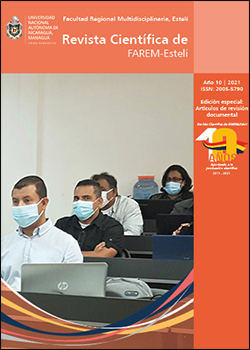Availability and adaptability of water resources in the Aguas Calientes sub-watershed (Somoto – San Lucas), Madriz
DOI:
https://doi.org/10.5377/farem.v0i0.11615Keywords:
Availability, adaptation, water resources, sub-watershed, co-management modelAbstract
The objective of this paper is to study the availability and adaptability of water resources in the Aguas Calientes sub- watershed (Somoto – San Lucas) department of Madriz. The methodology used was a documentary literature review, with data collection in electronic databases such as: E-libro, proquest and CNU repository, based on the model of adaptive co-management of watershed. Adaptation strategies included forest recovery, application of technology for rainwater harvesting and storage, protection of water source and producer associations as a micro-enterprise. The results of the studies indicate strategies and technologies applied by agricultural producer to adapt to climate variability and drought. On the other hand, it considers the adoption of the watershed approach as a planning tool for municipal government, which is of strategy importance due to the integration of the environment variables, mainly in terms of techniques to favor soils and water conservation. A change in the management of the sub-watershed is proposed, such as: diversification, financial feasibility of two crops adapted to drought and produced in the sub- watershed as henequen and pitahaya.
Downloads
References
Banegas, L., Jiménez, F., Locatelli, B., Faustino, J., & Campos, M. (2007). Evaluación de la adaptación de los productores. Recursos Naturales y Ambiente, 7.
Castellón, N. (2005). Gestión de Microcuencas como Estrategia de Planificación del Desarrollo Rural. Somoto, Nicaragua.
Cajina, M. (2006).Alternativas de captación de agua en la subcuenca del río Aguas Calientes para mejorar los beneficios socioeconómicos y ambientales de las comunidades de los municipios de Somoto y San Lucas, Nicaragua. Tesis Mag. Sc. Turrialba, CR, CATIE. 228 p.
Endeman C, y. J. (2002). Paradigmas en competencias en la investigación cualitativa. Obtenido de http://www.ustatunja.edu.co/cong/images/curso/guba_y_lincoln_2002.pdf
Faustino, J; Jiménez, F. (2005). El modelo de cogestión de cuencas hidrográficas en América Central. Disponible en: www.portalcuencas.net
Gómez, S. (2003). Análisis de vulnerabilidad con énfasis en sequía en la subcuenca del Río Aguas Calientes, Somoto, Nicaragua. Tesis Mag. Sc. Turrialba, CR, CATIE. 91 p.
INETER. (2012). DIRECCION GENERAL DE METEOROLOGIA. Obtenido de http://servmet.ineter.gob.ni/Meteorologia/climadenicaragua.php
Jiménez, F. (2005). Conceptos básicos en manejo de cuencas. Turrialba, Costa Rica: CATIE, 7 P.
Kammerbauer, H., León, J., Castellón, N., Gómez, S., & Prins, C. (2011). Modelo de cogestión adaptativa de. Recursos Naturales y Ambiente, 6.
MARENA (Ministerio del Ambiente y los Recursos Naturales). (2003). Informe del estado ambiental en Nicaragua. Managua.
Marin, A. M., Fernandez, D. N., Martínez, A. A., & Suárez, D. d. (2006). Calidad del Agua en la parte alta de las Cuencas Jusn Cojo y el Salado. Revista Facultad Nacional de Agronomía, 16.
Padrana, J. Á. (2018). Criterios de calidad y gestión del agua potable. Madrid: UNED - Universidad Nacional de Educación a Distancia.
Parra, O. 2009. Gestión Integrada de Cuencas Hidrográficas. Centro de Ciencias Ambientales, Universidad de Concepción, Chile.
Solomon, E. P., R, M. L., & W., B. y. (2013). Biología. Mexico: Cengage Learnig.
Toledo, A., Barragán, E., & Ortiz, J. (30 de Noviembre de 2005). Sustentabilidad Patrimonial de la Cuenca del Río Tepalcatepec. Obtenido de Turrialba: http://www.colmich.edu.mx/docencia/cer/colectivos/tepalcatepec/protocolo.htm
Published
Issue
Section
License
Copyright (c) 2021 Revista Científica de FAREM-Esteli

This work is licensed under a Creative Commons Attribution-NonCommercial-ShareAlike 4.0 International License.



